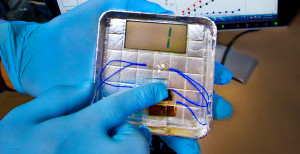 The Bacteriophage Power Generator generates power using harmless viruses that convert mechanical energy into electricity, providing a sustainable, cost-effective, nontoxic energy source capable of powering electronics and microdevices. It is unique in addressing the energy challenge of predominantly battery-driven devices. Developed by Seung-Wuk Lee working with Ramamoorthy Ramesh and Byung Yang Lee, all Berkeley Lab scientists, this generator is the first to produce electricity by harnessing the piezoelectric properties of a biological material.
The Bacteriophage Power Generator generates power using harmless viruses that convert mechanical energy into electricity, providing a sustainable, cost-effective, nontoxic energy source capable of powering electronics and microdevices. It is unique in addressing the energy challenge of predominantly battery-driven devices. Developed by Seung-Wuk Lee working with Ramamoorthy Ramesh and Byung Yang Lee, all Berkeley Lab scientists, this generator is the first to produce electricity by harnessing the piezoelectric properties of a biological material.
Because the energy-generating virus infects only bacteria, it is not harmful to humans and is biocompatible and nontoxic, unlike conventional piezoelectric materials such as lead, cadmium, and lithium. This opens the door to applications in biomedical devices, particularly those to be implanted into the human body. This invention is also a breakthrough in the concept of nanomanufacturing, as it exploits the unique natural ability of a virus to synthesize materials that can self-assemble and selfreplicate.



